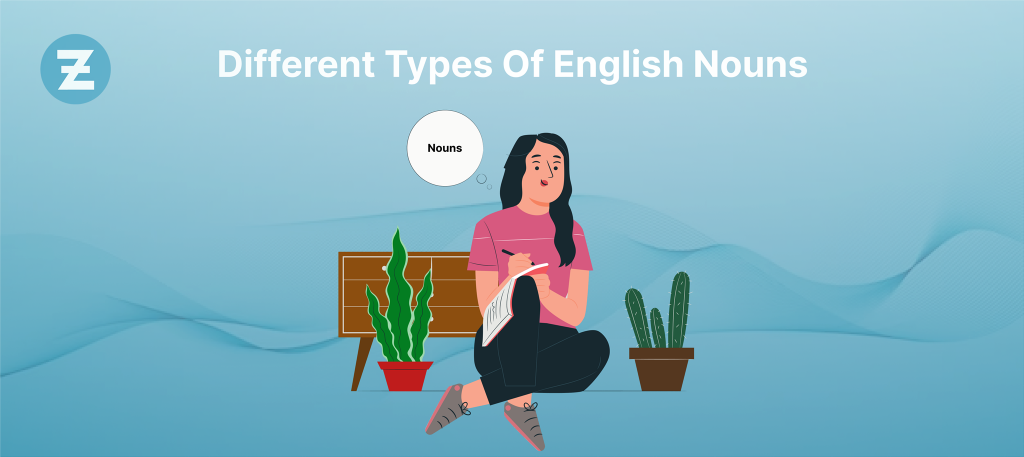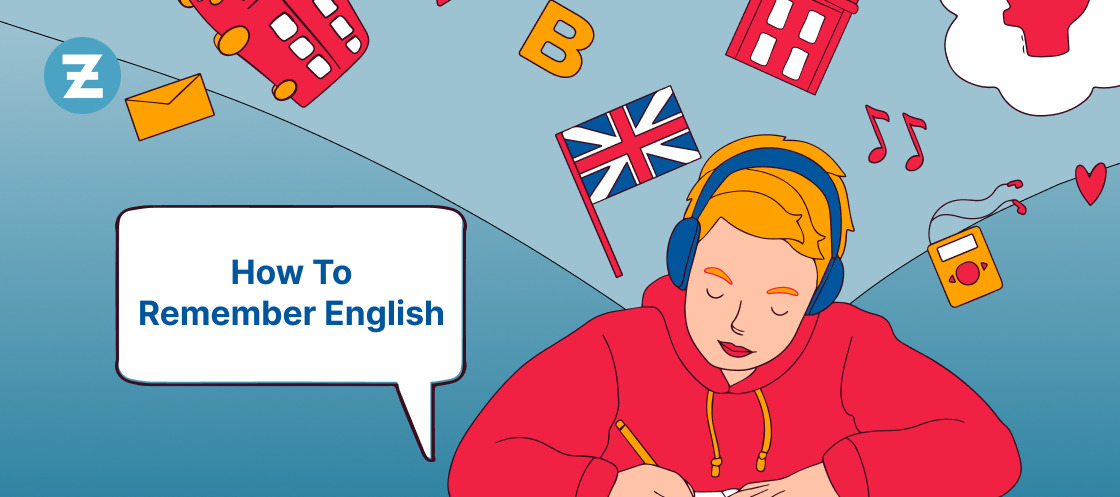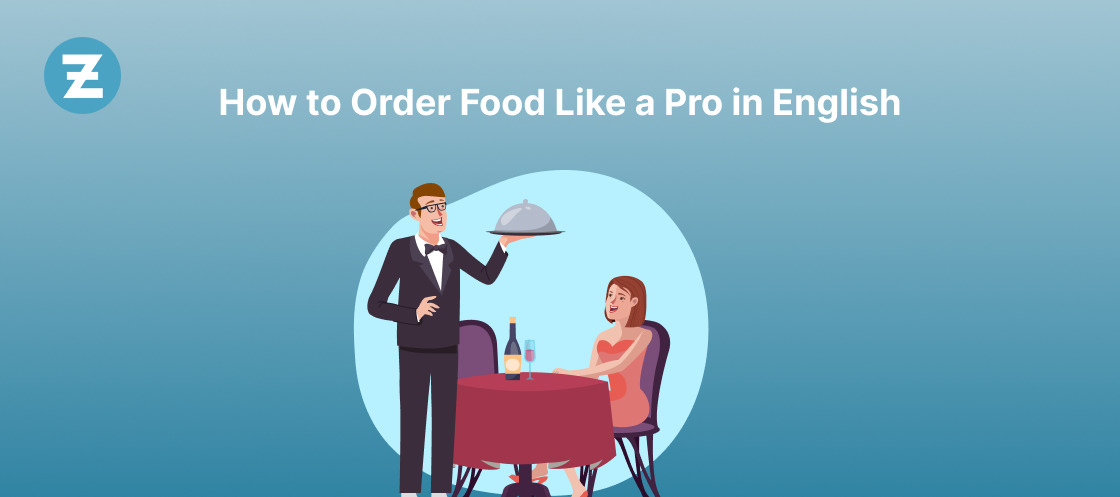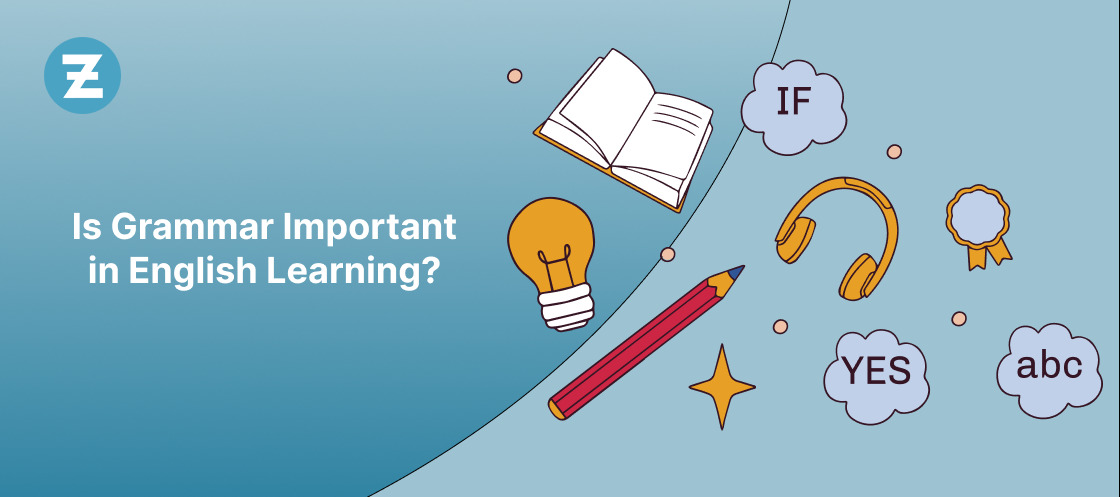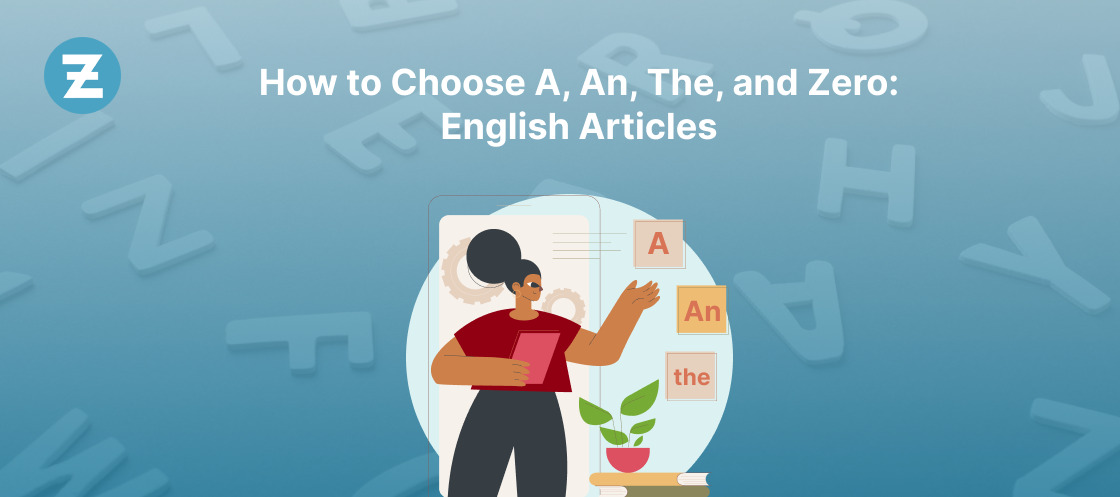English is a fascinating language with a rich and complex system of grammar rules. One of the key components of English grammar is the use of nouns. Nouns are essential for communicating effectively in English, allowing us to name people, places, things, and ideas. However, nouns come in many forms and can be categorized in various ways. In this blog, we will explore the different types of English nouns and provide an overview of their characteristics. Whether you are a beginner or a seasoned English speaker, understanding these different noun types can help you improve your writing and speaking skills.
Here are some common types of English nouns with examples,
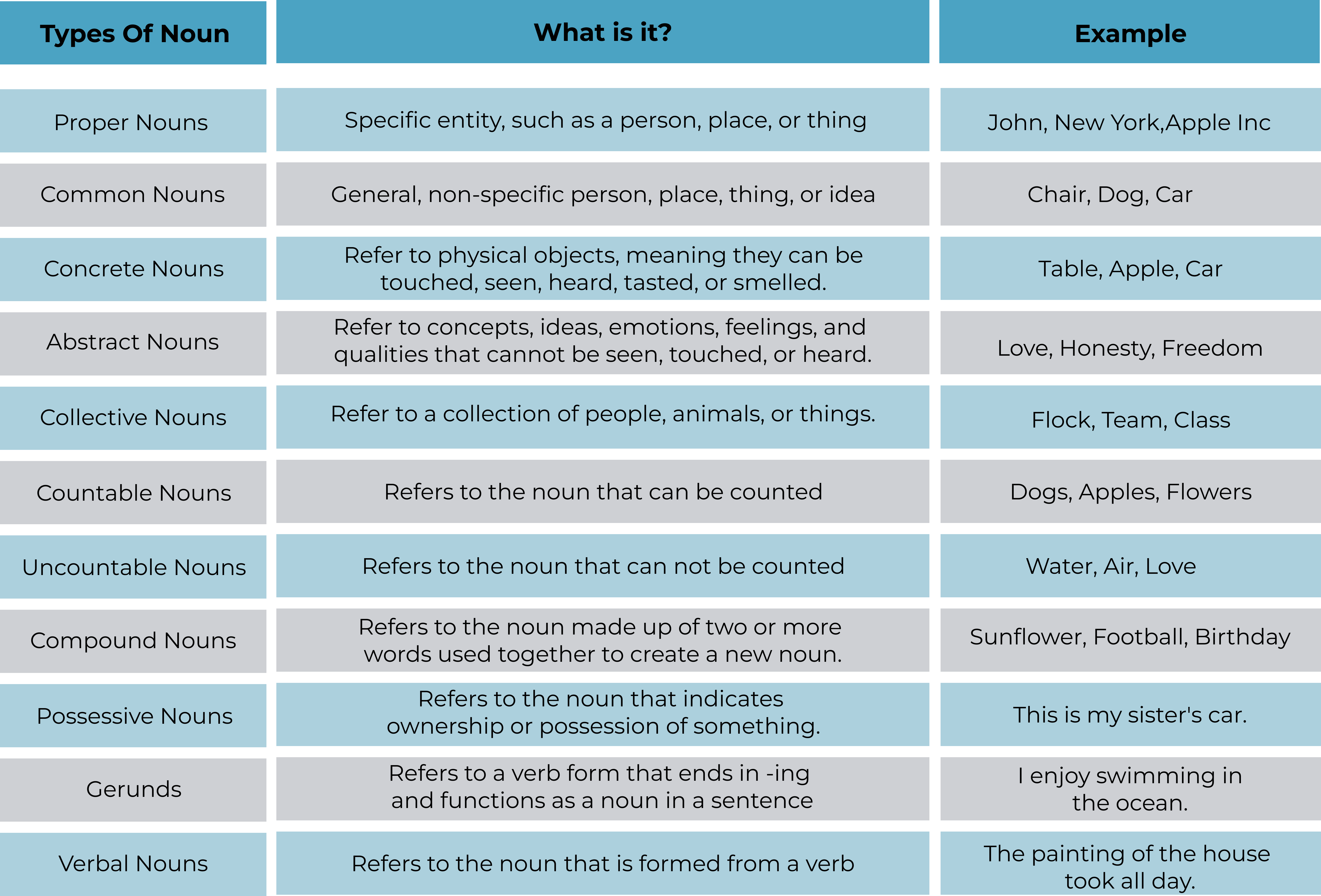
Proper Nouns
Proper nouns are a type of noun that refers to a specific entity, such as a person, place, or thing. These nouns are always capitalized, regardless of where they appear in a sentence.
For example, consider the word “dog.” It is a common noun because it refers to any canine animal. However, “Scooby Doo” is a proper noun because it refers to a specific dog from the cartoon series we all know and love.
Examples of Proper Nouns:
- People: John, Mary, Michael, Jennifer, etc.
- Places: New York, Paris, London, Tokyo, etc.
- Things: Coca-Cola, iPhone, Mercedes-Benz, Rolex, etc.
- Organizations: United Nations, Apple Inc., Microsoft Corporation, etc.
Common Nouns
A common noun is a type of noun that refers to a general, non-specific person, place, thing, or idea. These are the nouns we use daily, and they make up the majority of the words that we use in our conversations and writing.
For example, “car” is a common noun because it refers to any car, not a specific car. Similarly, “house” is a common noun because it refers to any type of house, not a specific one.
To help you understand this concept better, let’s look at some examples of concrete nouns.
- Chair – A chair is a physical object that can be seen, touched, and sat on. It is a concrete noun because it is a tangible object that can be perceived through our senses.
- Dog – A dog is an animal that we can see, hear, and touch. It is also a concrete noun because it is a physical object that can be perceived through our senses.
- Apple – An apple is a fruit we can see, taste, and touch. It is a concrete noun because it is a tangible object that can be perceived through our senses.
- Car – A car is a physical object we can see, touch, and hear. It is a concrete noun because it is a tangible object that can be perceived through our senses.
- Tree – A tree is a physical object that we can see, touch, and smell. It is a concrete noun because it is a tangible object that can be perceived through our senses.
Read Also: Ways to improve your English listening skills
Concrete Nouns
Concrete nouns refer to physical objects, meaning they can be touched, seen, heard, tasted, or smelled. They exist in the physical world and can be perceived by the senses.
One of the key features of concrete nouns is that they can be counted. For instance, if you have two apples, you can count them and say, “I have two apples.” Similarly, if you see a group of dogs, you can count them and say, “There are five dogs over there.” Adjectives can also modify concrete nouns to provide more information about the object. For example, you could say, “I have a juicy apple,” “I drive a red car,” or “I use a black pen.”
Concrete nouns are an essential part of our daily lives, and we use them in our conversations to describe things around us. For instance, when we say, “I see a red car,” we use two concrete nouns, “car” and “red.” These nouns help us to paint a picture in our minds of the object being described.
Abstract Nouns
Abstract nouns refer to concepts, ideas, emotions, feelings, and qualities that cannot be seen, touched, or heard. They are intangible and describe things in the mind or the imagination.
For example, “peace” is an abstract noun that refers to calmness or tranquility. “Bravery” is also an abstract noun because it refers to a quality or characteristic that cannot be seen or touched.
Abstract nouns are important in literature, poetry, and other art forms. They often convey deeper meanings and emotions that concrete language cannot express. For example, the poem “The Love Song of J. Alfred Prufrock” by T.S. Eliot uses abstract nouns such as “loneliness,” “doubt,” and “despair” to convey the speaker’s emotional state.
Here are some common examples of abstract nouns:
- Love: Love is an emotion that cannot be seen or touched. It is a feeling that exists only in our minds.
- Honesty: Honesty is a quality that cannot be seen or touched. It is a concept that exists only in our minds.
- Freedom: Freedom is an idea that cannot be seen or touched. It is a concept that exists only in our minds.
- Courage: Courage is a quality that cannot be seen or touched. It is a concept that exists only in our minds.
- Knowledge: Knowledge is an idea that cannot be seen or touched. It is a concept that exists only in our minds.
Read Also: Most Commonly Used English Verbs and Their Meanings
Collective Nouns
Collective nouns are words that describe a group of individuals or objects. They are singular in form but refer to a collection of people, animals, or things. Collective nouns can describe a wide range of groups, from a flock of birds in the sky to a team of athletes on the field.
Collective nouns are particularly useful when we want to refer to a group of things without naming each individual. For instance, instead of saying, “John, Sarah, and Tim went to the store,” we can say, “The group went to the store.” This not only saves time but also simplifies the sentence.
Here are some common examples of collective nouns:
- Flock – a group of birds
- Herd – a group of cows or other grazing animals
- Swarm – a group of insects
- Pack – a group of wolves or other wild animals
- Team – a group of players in a game or sport
- Crew – a group of workers on a ship or airplane
- Band – a group of musicians
- Committee – a group of people assigned to a specific task or responsibility
- Class – a group of students in a school or university
- Audience – a group of people watching a performance or presentation
Countable Nouns
A countable noun is a type of noun that can be counted, and it has singular and plural forms.
For example, “apple” is a countable noun because we can count the number of apples we have. We can have one apple or many apples.
To better understand countable nouns, let’s take a look at some examples:
- Cars – You can count cars using numbers. For example, “I saw five cars on my way to work.”
- Ideas – Even though ideas are abstract, they are still countable. For example, “I have three ideas for my next book.”
- Dogs – You can count dogs using numbers. For example, “I have two dogs at home.”
- Mountains – Mountains are concrete countable nouns. For example, “I climbed three mountains last year.”
- Flowers – You can count flowers using numbers. For example, “I picked ten flowers from the garden this morning.”
Read Also: Common English connectors used in everyday conversations
Uncountable Nouns
Uncountable nouns are a type of noun that cannot be counted or quantified. They are usually used to describe substances, concepts, or ideas considered indivisible or continuous.
For example, you can’t say “two sugars” to mean two grains of sugar. Instead, you would say “two spoons of sugar” or “two packets of sugar.” Similarly, you can’t say “three rices” to mean three rice grains. Instead, you would say, “Three bowls of rice.”
Here are some examples of uncountable nouns:
- Water: Water is essential for life, but you can’t count it. You can’t say, “I have three waters.” You can only say, “I have some water.”
- Air: Air is another essential element that we cannot count. We can’t say, “I took two airs.” We can only say, “I breathed some air.”
- Sugar: Sugar is a substance that we use in our daily lives, but we can’t count it. We can’t say, “I have three sugars.” We can only say, “I added some sugar.”
- Love: Love is a concept that we cannot quantify. We can’t say, “I have two loves.” We can only say, “I feel love for you.”
- Advice: Advice is another example of an uncountable noun. We can’t say, “I gave two advices.” We can only say, “I gave some advice.”
Compound Nouns
A compound noun is a noun made up of two or more words used together to create a new noun. These words can be any combination of nouns, verbs, adjectives, or other parts of speech, and they are combined to form a single, new noun with a specific meaning. The words that make up a compound noun can be written separately, hyphenated, or combined into a single word, depending on the specific compound noun.
For example, suppose you have two words, “tooth” and “brush.” When you combine these two words, you get a new noun, “toothbrush,” which refers to a brush used for cleaning teeth.
Here are some examples of common compound nouns:
- Sunflower – A flower that looks like the sun.
- Football – A sport played with a ball using feet.
- Snowman – A figure made of snow with features like arms, a hat, and a carrot nose.
- Headphones – A pair of electronic devices worn on the head to listen to audio.
- Waterfall – A cascade of water falling from a height.
- Birthday – The anniversary of the day on which a person was born.
- Toothpaste – A paste used for cleaning teeth.
- Newspaper – A publication that is printed on paper and contains news and other information.
- Firefighter – A person trained to extinguish fires and rescue people from burning buildings.
Read Also: Famous English Proverbs With Their Meaning
Possessive Nouns
Possessive nouns are a type of noun that indicates ownership or possession of something. They are used to show that something belongs to or is associated with a specific person, place, or thing.
For example, if you want to show that a book belongs to Sarah, you would write “Sarah’s book.” If you want to show that a car belongs to John, you will write “John’s car.” This simple rule applies to most nouns.
Here are some common examples of Possessive Nouns:
- The company’s profits have increased this year.
- My dad’s cooking is the best.
- The children’s laughter filled the room.
- This is my sister’s car.
- The teacher’s lesson plan
- The employee’s desk
- The children’s toys
- The cats’ tails
Gerunds
Gerunds are a verb form that ends in -ing and functions as a noun in a sentence.
For example, Swimming is my favorite form of exercise. Here, swimming’ is the sentence’s subject, making it a noun. It functions as a subject, just like any other noun would. It is important to note that gerunds are not the same as present participles, which also end in -ing. Present participles function as adjectives, whereas gerunds function as nouns.
Gerunds can also be used in a variety of other ways. They can be used as the object of a verb, the object of a preposition, and the subject of an infinitive. Here are some examples:
- Object of a verb: “I enjoy swimming in the ocean.”
- Object of a preposition: “I am thinking about going swimming.”
- Subject of an infinitive: “My goal is to improve my swimming technique.”
Verbal Nouns
A verbal noun is a noun that is formed from a verb. These nouns can describe an action, an event, or a state of being, depending on the context in which they are used.
For example, “I enjoy reading.” In this sentence, “reading” is a verbal noun that functions as the object of the verb “enjoy.”
Here are some examples of verbal nouns in action:
– The running of the marathon was a great success.
– The education of children is a top priority for many parents.
– The painting of the house took all day.
– The construction of the new building is on schedule.
– The singing of the national anthem was a moving experience.
To Sum Up
To master the English language and enhance your communication skills, it is crucial to comprehend the various types of nouns in existence. Whether proper nouns, common nouns, concrete nouns, or abstract nouns, each type uniquely conveys meaning and shapes the language we use. By familiarizing yourself with these different types of nouns, you’ll be better equipped to express yourself clearly and effectively in written and spoken English. So the next time you encounter a noun in your reading or conversation, take a moment to identify its type and appreciate the power of this essential part of speech in mastering the English language. If you want to enhance your English language skills, you can try the free language improvement app designed to make it easy to improve your English. With Zoundslike, you can develop your language skills quickly and effectively. Don’t wait any longer. Download today!
FAQs
Q.1 What is the definition of a noun?
A noun is a word that represents a person, place, thing, or idea. It is a fundamental part of speech in English grammar. Nouns serve as the building blocks of sentences, providing the subject or object of a sentence. They can be concrete, such as ‘chair’ or ‘dog’, or abstract, such as ‘love’ or ‘happiness’.
Q.2 What are the different types of nouns?
In the English language, there are several types of nouns. These include common nouns, proper nouns, countable nouns, uncountable nouns, concrete nouns, abstract nouns, collective nouns, and compound nouns.
Q.3 What’s the difference between a noun and a pronoun?
A noun is a word that represents a person, place, thing, or idea. It functions as the subject or object of a sentence. Examples of nouns include ‘dog’, ‘city’, and ‘happiness’.
On the other hand, a pronoun is a word used to replace a noun. It is used to avoid repetition and make sentences less repetitive. A pronoun can be substituted instead of using the same noun multiple times. Examples of pronouns include ‘he’, ‘she’, ‘it’, and ‘they’.


